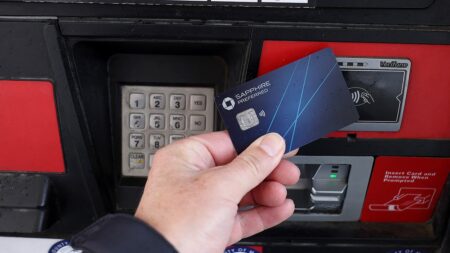Americans are increasingly turning to their credit cards to cover everyday expenses, with debt hitting a new record high at the end of September, according to a New York Federal Reserve report published Tuesday.
In the three-month period from July to September, total credit card debt surged to $1.08 trillion, an increase of $48 billion, or 4.6% from the previous quarter, according to the report. It marks the highest level on record in Fed data dating back to 2003 and the eighth consecutive annual increase.
“Credit card balances experienced a large jump in the third quarter, consistent with strong consumer spending and real GDP growth,” said Donghoon Lee, a New York Fed economist, in a press release.
There was also an uptick in borrowers who are struggling with credit card, student and auto loan payments. As of September, about 3% of outstanding debt was in some stage of delinquency, up from the 2.7% recorded the previous quarter but still down from the average 4.7% rate seen before the COVID-19 pandemic began.
401(K) HARDSHIP WITHDRAWALS ARE SURGING AS HIGH INFLATION SQUEEZES AMERICANS
Credit card delinquencies continued to rise from their pandemic-era lows in the third quarter, and the number of newly delinquent individuals has actually surpassed the typical pre-pandemic level. The flow of debt moving into delinquency hit 1.28% in the third quarter, compared to 0.94% during the same time one year ago. The increase was most pronounced among individuals between the ages of 30 and 39, the report said.
There are likely several reasons to blame for the rise in delinquencies. New York Fed researchers told reporters during a call Tuesday morning that the increase could reflect a loosening of tightening standards over the past few years, an overextension by lenders and borrowers or a sign of financial troubles at home amid ongoing inflation and high interest rates.
“It could be that there is some stress building, that people are losing jobs, income, there could be real financial stress building up, maybe because of high inflation,” the researchers said. “It could be a combination of all those three. They all play a role, and maybe different groups are affected differently by these factors.”
The rise in credit card usage and debt is particularly concerning because interest rates are astronomically high right now. The average credit card annual percentage rate, or APR, hit a new record of 20.72% last week, according to a Bankrate database that goes back to 1985. The previous record was 19% in July 1991.
A FED PAUSE LIKELY WON’T HELP STRUGGLING CONSUMERS
If people are carrying debt to compensate for steeper prices, they could end up paying more for items in the long run. For instance, if you owe $5,000 in debt — which the average American does — current APR levels would mean it would take about 279 months and $8,124 in interest to pay off the debt making the minimum payments.

The increase in the credit card category helped to push total household debt to a staggering $17.29 billion, a $228 billion – or 1.3% – increase from the end of June. Balances are now $2.9 trillion higher than they were at the end of 2019, before the COVID-19 pandemic began.
Auto loan balances also contributed to the uptick, climbing by $13 billion over the course of the third quarter to $1.6 trillion. Student loan debt, meanwhile, increased by $30 billion while mortgage balances jumped by $126 billion to $12.14 trillion.
The rise in balances comes in the midst of the Federal Reserve’s aggressive interest rate-hike campaign as it tries to crush stubborn inflation and cool the economy.
Although inflation has cooled considerably in recent months, it remains up 3.7% compared with the same time one year ago, according to the most recent Labor Department data.
The inflation spike has created severe financial pressures for most U.S. households, which are forced to pay more for everyday necessities like food and rent. The burden is disproportionately borne by low-income Americans, whose already-stretched paychecks are heavily affected by price fluctuations.
Read the full article here









